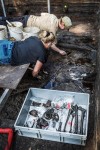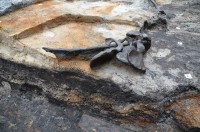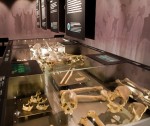 The Alken Enge wetlands in East Jutland, Denmark, continues to produce exceptional and exceptionally gruesome finds. Thanks to the history-preserving wonder of peat, the remains of more than 200 Iron Age warriors who were sacrificed after a defeat in battle around 1 A.D. have been unearthed from in excavations from the 1950s to the present. The 2012 dig found a skull with a hole in the back from a projectile or spear, a thighbone hacked in half, numerous other bones and well-preserved weapons including an axe with its entire wooden shaft intact. The teeth on the pierced skull were in good enough condition for a testable sample of DNA to be extracted.
The Alken Enge wetlands in East Jutland, Denmark, continues to produce exceptional and exceptionally gruesome finds. Thanks to the history-preserving wonder of peat, the remains of more than 200 Iron Age warriors who were sacrificed after a defeat in battle around 1 A.D. have been unearthed from in excavations from the 1950s to the present. The 2012 dig found a skull with a hole in the back from a projectile or spear, a thighbone hacked in half, numerous other bones and well-preserved weapons including an axe with its entire wooden shaft intact. The teeth on the pierced skull were in good enough condition for a testable sample of DNA to be extracted.
 This year’s excavation has discovered evidence that the sacrifice of victims didn’t just happen in the immediate aftermath of the battle, but rather that remains were left to rot where they fell for six months before being butchered for ritual purposes. Cut and scrape marks on bones mutely testify to how the rotted flesh was removed from the bones. The bones were then sorted and collated for sacrifice: bones were bundled together, skulls were crushed, and in one particularly gruesome find, four pelvic bones were mounted on a wooden stick.
This year’s excavation has discovered evidence that the sacrifice of victims didn’t just happen in the immediate aftermath of the battle, but rather that remains were left to rot where they fell for six months before being butchered for ritual purposes. Cut and scrape marks on bones mutely testify to how the rotted flesh was removed from the bones. The bones were then sorted and collated for sacrifice: bones were bundled together, skulls were crushed, and in one particularly gruesome find, four pelvic bones were mounted on a wooden stick.
Here’s a 3D video composite of the pelvises in situ:
Once sorted and desecrated, the bones were thrown into the ancient lake that would become today’s bog along with animal remains and clay pots that archaeologists believe probably contained food offerings.
“We are fairly sure that this was a religious act. It seems that this was a holy site for a pagan religion – a sacred grove – where the victorious conclusion of major battles was marked by the ritual presentation and destruction of the bones of the vanquished warriors,” adds [Aarhus University Project Manager] Mads Kähler Holst.
Geological studies have revealed that back in the Iron Age, the finds were thrown into the water from the end of a tongue of land that stretched out into Mossø lake, which was much larger back then than it is today.
“Most of the bones we find here are spread out over the lake bed seemingly at random, but the new finds have suddenly given us a clear impression of what actually happened. This applies in particular to the four pelvic bones. They must have been threaded onto the stick after the flesh was cleaned from the skeletons,” explains Field Director Ejvind Hertz from Skanderborg Museum.
We still don’t know exactly where the fallen warriors came from, whether they were local fighters or other Germanic peoples attempting to move northwards under pressure from Roman activity across the Alps.
If you’re fortunate enough to be summering in Jutland right now, the Alken Enge site will be open to the public for guided tours on Thursday, July 31st, and 3:00 PM and 5:00 PM. The tours are free but you must register ahead of time so they can control numbers. The maximum number of people allowed is 200 per tour. You can register online on the website of the Skanderborg Museum here.
 The artifacts and remains from the Alken Enge digs are being conserved at the Skanderborg Museum, and some of the more exceptional finds are on display there, including the four pelvises on a stick. The exhibition has been four years in the making and covers not just the history of the site, what the science says took place there 2,000 years ago, but also the history of archaeological explorations of the bog from the 19th century to the high tech laboratory work of modern day archaeologists. As soon as I find that winning lottery ticket someone dropped, I’m making a beeline for this show.
The artifacts and remains from the Alken Enge digs are being conserved at the Skanderborg Museum, and some of the more exceptional finds are on display there, including the four pelvises on a stick. The exhibition has been four years in the making and covers not just the history of the site, what the science says took place there 2,000 years ago, but also the history of archaeological explorations of the bog from the 19th century to the high tech laboratory work of modern day archaeologists. As soon as I find that winning lottery ticket someone dropped, I’m making a beeline for this show.